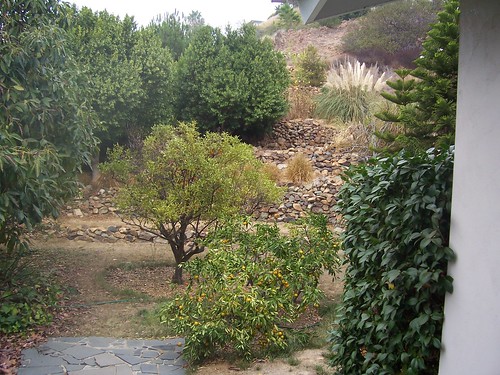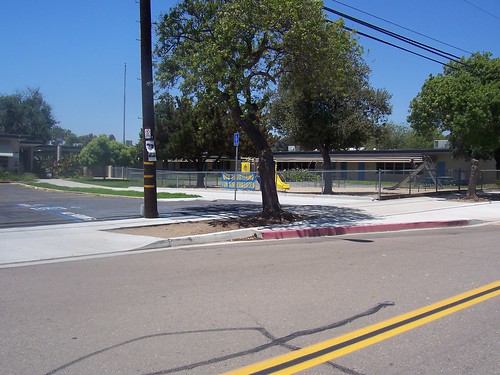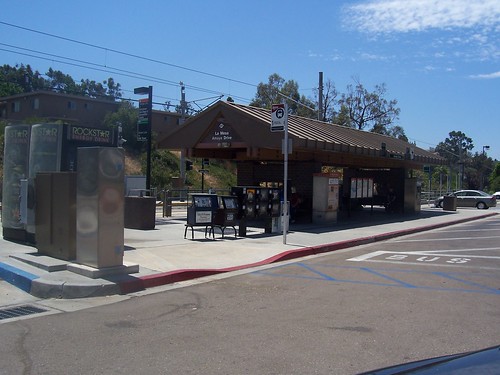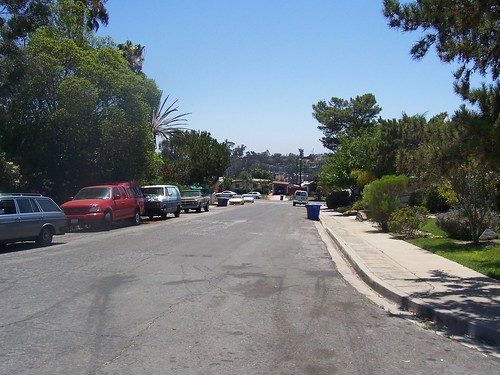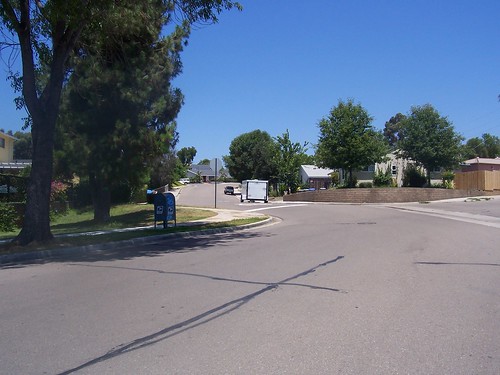Dan Melson: August 2008 Archives
Newly Written Articles
Consumer Focused Carnival of Real Estate
Rent to Own and Lease With Option to Buy, talking about a common alternative that allows sellers to market to people who would not otherwise be able to qualify, and buyers to qualify when they would not otherwise. But there are pitfalls.
What If You Cannot Refinance Later?, dealing head-on with an assumption implicit in quite a lot of real estate advice and thinking.
Negotiation Basics: On What to Offer and Whether to Offer talks about some of the criteria for what is a good offer and what is not, as well as deciding whether to make an offer at all.
Updated Articles
Mortgage Closing Costs: What is Real and What is Junk?
These are newly listed HOMESTEPS properties from Freddie Mac.
If you have questions, Contact me
El Cajon:
Address: 1509 E WASHINGTON AVE UNIT 10, EL CAJON, CA
Rooms: 4 Bed: 2 Bath: 2.0 Price: 144,900.00
Address: 11354 VIA RANCHO SAN DIEGO UNI, EL CAJON, CA
Rooms: 4 Bed: 2 Bath: 2.5 Price: 229,900.00
Address: 294 CHAMBERS STREET 53, EL CAJON, CA
Rooms: 3 Bed: 1 Bath: 1.0 Price: 94,900.00
Address: 170 CHAMBERS STREET 18, EL CAJON, CA
Rooms: 4 Bed: 2 Bath: 2.0 Price: 104,900.00
Address: 170 CHAMBERS STREET 16, EL CAJON, CA
Rooms: 4 Bed: 2 Bath: 2.0 Price: 118,000.00
Address: 1797 WOODBURN STREET, EL CAJON, CA
Rooms: 5 Bed: 3 Bath: 2.0 Price: 349,900.00
Address: 745 EAST BRADLEY AVENUE 37, EL CAJON, CA
Rooms: 4 Bed: 2 Bath: 1.0 Price: 99,000.00
Address: 1321 GREENFIELD DRIVE, EL CAJON, CA
Rooms: 6 Bed: 2 Bath: 1.5 Price: 121,200.00
Address: 1423 GRAVES AVENUE 230, EL CAJON, CA
Rooms: 4 Bed: 2 Bath: 2.0 Price: 131,300.00
Address: 1526 STONE EDGE CIRCLE, EL CAJON, CA
Rooms: 5 Bed: 2 Bath: 1.5 Price: 209,500.00
Santee:
Address: 7895 RANCHO FANITA DR E, SANTEE, CA
Rooms: 5 Bed: 3 Bath: 1.5 Price: 259,900.00
Address: 10235 BRIGHTWOOD LANE 3, SANTEE, CA
Rooms: 5 Bed: 3 Bath: 3.5 Price: 318,900.00
Address: 8803 APPLE BLOSSOM CT 5, SANTEE, CA
Rooms: 8 Bed: 4 Bath: 4.0 Price: 319,900.00
Lakeside:
Address: 9932 LINDO LAKE PLACE, LAKESIDE, CA
Rooms: 8 Bed: 3 Bath: 2.0 Price: 259,900.00
San Diego City
Address: 6333 COLLEGE GROVE WAY, SAN DIEGO, CA
Rooms: 4 Bed: 2 Bath: 1.5 Price: 136,350.00
Address: 4775 SEMINOLE DRIVE 207, SAN DIEGO, CA
Rooms: 5 Bed: 2 Bath: 1.5 Price: 159,500.00
Address: 4287 48TH STREET, SAN DIEGO, CA
Rooms: 5 Bed: 2 Bath: 1.0 Price: 218,500.00
Address: 1441 CAMINO ZALCE, SAN DIEGO, CA
Rooms: 5 Bed: 2 Bath: 2.5 Price: 292,500.00
Today's new consumer article is Rent to Own and Lease With Option to Buy, which talks about one alternative to the traditional sale that usually gets a seller a higher price, while not requiring a buyer to come up with cash for a down payment. However, there are pitfalls for both parties.
Lender Owned, Great Neighborhood!
General: La Mesa, 3 Bedroom plus optional, 2.25 Bathroom
Con:
What's Wrong With It: All the surfaces are old, and it needs refurbishing. Floor plan has dividers it doesn't need.
Why It Hasn't Sold: People can't see the payoff
Who it's Not Appropriate For: People who can't handle stairs.
Pro:
Selling Points: Nice large back yard, lots of storage underneath the house. Has great views of the neighborhood, and sits in an excellent school district.
Who Should be Interested: Anybody looking to buy into a great neighborhood at a bargain price!
Why it's a Bargain: Everything around it is much more expensive. There's nothing cheaper in the neighborhood!
Financial:
What I think I can get it for: $320,000.
Investment potential: If you keep it ten years and it averages only 5% annual average appreciation per year: Based upon a purchase price of $320,000 the property would be worth approximately $530,000. If you held it those ten years before selling, you would net about $250,000 in your pocket (not including increased value from updates!), assuming zero down payment. As opposed to renting the $2200 per month most comparable currently available rental and investing the difference at 10% per year tax free, you would be approximately $280,000 ahead of the renter, after the expenses of selling.
To learn more: Agree that you'll use me as a buyer's agent if you buy it. If you don't like it or don't buy it, no obligation is incurred. If you're not working with someone who will go out and find properties like this, maybe you should consider working with me instead!
Contact Information:
Dan Melson, Buyer's Agent
One Stop Lending And Realty, Inc
9025 Carlton Hills Blvd, Suite B
Santee, CA 92071
619-300-7425
Today's new consumer article is What If You Cannot Refinance Later?, which addresses a very real concern that there are many reasons why people may not be able to refinance their property at a later date, so even though the currently available loans may not save you any money now, moving from an unsustainable loan to a sustainable loan now will save your bacon later.
This is a new series I'm starting, on the neighborhoods of the area I primarily work, which includes La Mesa, San Carlos, El Cajon and Santee. For this one, I'm back on the west side of La Mesa: Connecticut Avenue
This neighborhood is bounded by the San Diego City Limits, Lake Murray Boulevard, and Lake Murray itself, and sits on the side of a hill above where Lake Murray would drain if anything ever happened to the dam. The adjacent area of San Diego City may be a little more recent, but sits on lower softer ground. The block or so immediately north of Interstate 8 does get freeway noise, but the rest of the neighborhood is quiet due to the way the hill slopes.
Pennsylvania Avenue, looking south (downhill)
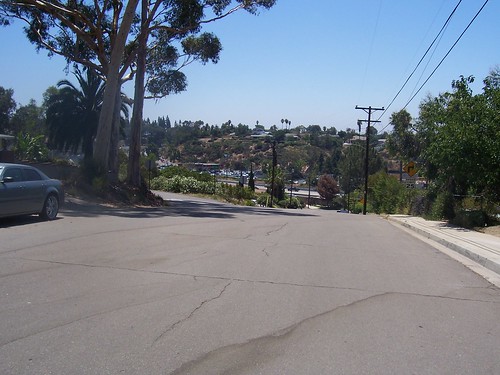
There really isn't a commercial road serving the area. Lake Murray Boulevard has a few businesses right around Parkway Drive which is how most people get in and out, but the neighborhood itself is exclusively residential. The views vary from good to excellent, looking out over the Alvarado Creek area and San Diego State, with the properties at the top of the hill having views over all of eastern San Diego.
Lake Murray Boulevard and Parkway Drive, from the bottom of Connecticut:
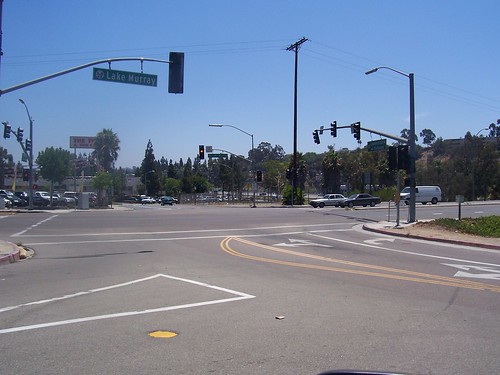
Physically, the houses are mostly single story 3 and 4 bedroom, 2 bath houses from around 1200 square feet to around 1600, sitting on lots of about 6500 to 8000 square feet. Many have been added onto, and they've pretty much all got individual character - a few were built as fill in or replacement in the 1970s and 1980s, but most were built in the 1950s and late 1940s, before the tract cookie cutter became a developer staple. Many use the older pier support, but concrete foundations became mandatory before the neighborhood was finished. Foundation issues and settling are rare, and those that existed have mostly long since been dealt with. As of this writing, asking prices start at about $360,000, but there are only four properties for sale in the neighborhood.
Here's an example of the typical home in the neighborhood
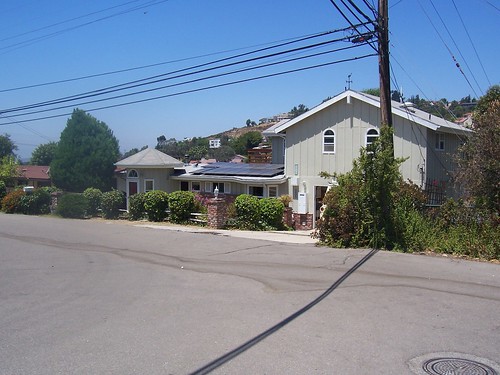
Here's one of the infill properties, built circa 1980
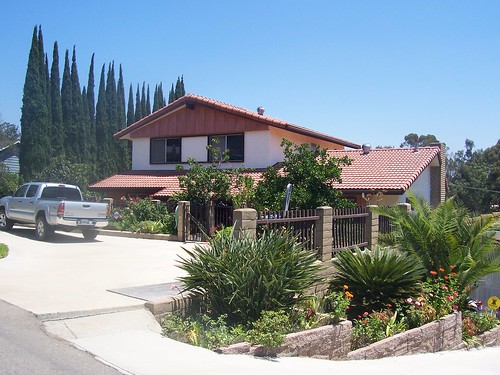
The neighborhood schools are Maryland Avenue, (A Smart Steps Preschool site, according to their website). The Middle School is La Mesa Middle School (formerly La Mesa Junior High), and the high school is Helix Charter. Helix, in particular, has a long record of academic achievement. Here's the most recent account Helix Accountability Report Card
The closest community college is Grossmont, the closest four year college is San Diego State University, which is actually closer.
Here you can see San Diego State University from the neighborhood
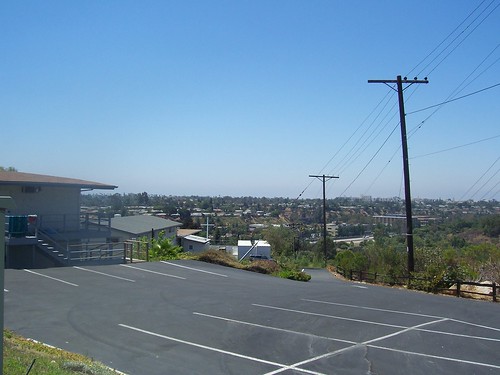
Connecticut Avenue is a very nice neighborhood to live in, with good transportation access. It's two minutes to Interstate 8. You have your choice of several major supermarkets within a mile or so. You can get to Mission Valley in less than ten minutes, downtown in about 20. The San Diego Trolley runs adjacent to Interstate 8, and has stops at Alvarado Hospital and just east of 70th Street, and Lake Murray Boulevard is a bus route. Major shopping centers are found at Grossmont Center (Target, Wal-Mart, Macy's, Theaters and dining), and all the Mission Valley shopping is also very close, as is the park and trails of Lake Murray
Lake Murray Dam and trails, from Delaware Street:
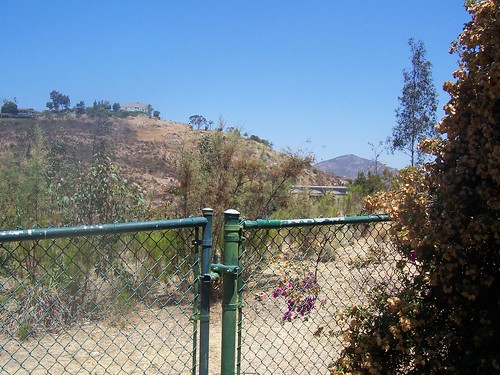
If you'd like to talk more about Connecticut Avenue or any other neighborhood of La Mesa, Contact me. I will be happy to discuss which neighborhoods might be right for you, or the marketing of your current property.
A typical internal view, from Connecticut and Colorado. Notice all the mature shade trees? It makes a real difference!
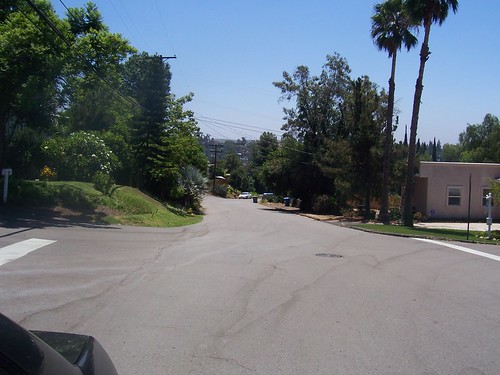
Today's new consumer article is Negotiation Basics: On What to Offer and Whether to Offer, Which talks about the process of putting in an offer and negotiation, and what effects a couple of common things have upon the process.
Newly Written Articles
Finding or Creating a "Green" or Eco-Friendly House talks about the basics of ecologically friendly dwellings
Loan Qualification Standards: Qualifying Rate and Payment discusses the exact way in which debt to income ratio is computed with various loan types.
The Moment of Truth, Signing Bad Loan Documents and the Right of Rescission goes over what to do when the final loan documents are not what you were led to expect. It happens more often than you think.
Updated Articles
Mortgage Rate, Points, and Closing Costs is a reprint of some very basic information on what they are, and the interactions between them.
Fixed rate, Balloon, ARM and Hybrid Loans is a reprint discussing some very basic information: the difference between the term and amortization of a loan.
Refinancing When The Rates Are Higher is an article talking about what to do when the refinancing rates available are worse than what you've already got.
Negotiations After the Purchase Contract: Seller's Allowances and Fixing Problems talks about the mindset to have when subsequent negotiations are necessary.
This is a the another in the series on the neighborhoods of the area I primarily work, which includes La Mesa, San Carlos, El Cajon and Santee. This time I'm moving to the eastern side of La Mesa, the area around Harry Griffen Park and Grossmont High School.
Griffen Park is a couple hundred acres right out of the middle of the area:
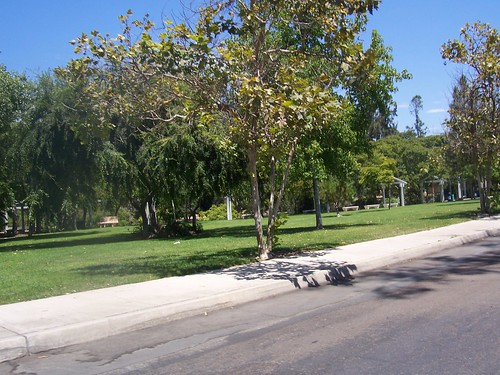
Griffen Park is probably the largest park in La Mesa. There's probably enough grass for a soccer league, a Pop Warner league, and a softball league to hold all their weekly games at the same time without interfering with each other:
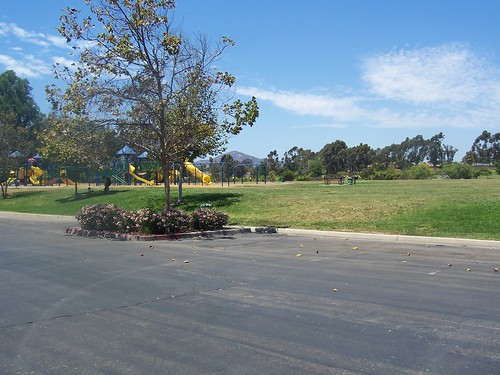
The Griffen Park neighborhood is bounded by Grossmont Center, Interstate 8, El Cajon City Limits, and Amaya Drive. The area immediately across Interstate 8 is pretty similar, which shouldn't be a surprise because this was originally one neighborhood that was split when the interstate came through. Once you're off the main streets, it's quiet. There's even a hidden area that feels like the country that you can miss if you don't know where to look.
The double-secret hidden area. I could tell you, but then I'd have to kill you :-)
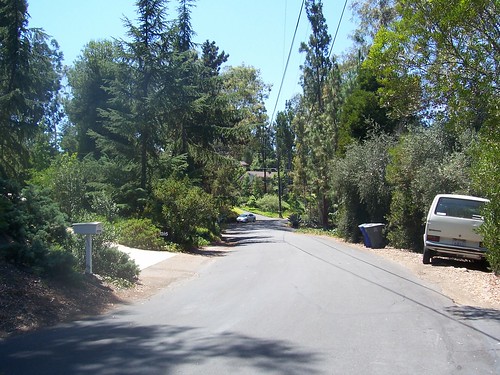
The main commercial artery in the area is Murray Street, which would feel almost like the main street of a one stoplight town if Interstate 8 wasn't right next to it. There's maybe a couple dozen businesses there, and that includes places of worship and Grossmont High School. The rest of the area is all residential except for Griffen Park.
The homes were mostly built in the 1950s, with a significant percentage being built up to 30 years earlier. There are a few modern infill developments, the largest of which is off Milden Street behind the high school. The houses probably average 3 to 4 bedroom, right around 1600 square feet, on lots of about 7000 square feet. There are more tract homes here than in most other neighborhoods of La Mesa, but they've had the time to get added onto, so when you're driving through the neighborhoods, they don't look like somebody made them all with the same cookie cutter. There isn't much high density housing here - one fairly new townhome project is the only common interest development I can think of. This neighborhood is about 99 percent single family detached homes with no HOA. Not surprisingly, there usually aren't a lot of properties for sale in the area. As of right now, there's one beater with an ask of $300,000, but the next lowest asking price is $430,000, and they go up to $800,000. Families making San Diego Area Median Income (a little over $72,000 per year) will probably need a significant down payment to qualify for all but the cheapest homes in the neighborhood.
The name of this street is Urban, a real misnomer.
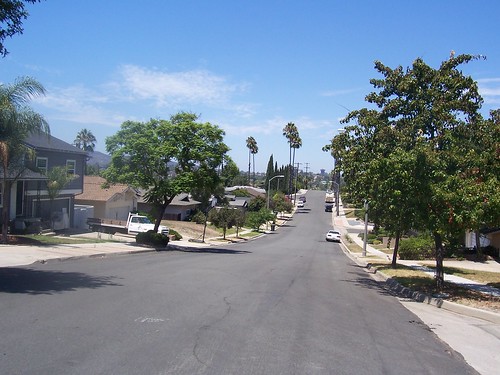
This is not a dense urban neighborhood. The streets are fairly straight, but there aren't always sidewalks, and other than nosy agents, there just aren't a lot of people in the area who don't live here, especially once you get off of Murray and Severin, where the easiest freeway access is. It's a pretty quiet place to live for the most part, and you would definitely get the wrong impression if you only drove the commercial streets.
Another street in the neighborhood:
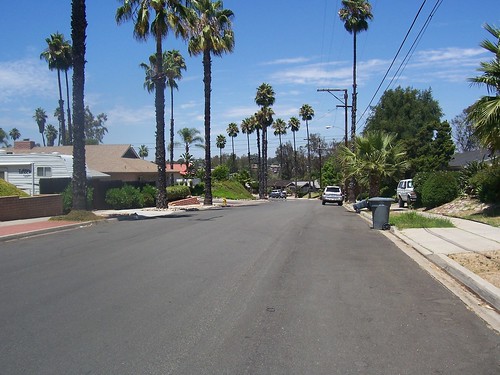
The neighborhood school is Northmont. The Middle School is Parkway Middle School (formerly Parkway Junior High), and the high school is Grossmont High School, the oldest high school in the Grossmont District. Here's the most recent account Grossmont Accountability Report Card
Grossmont High School Entrance
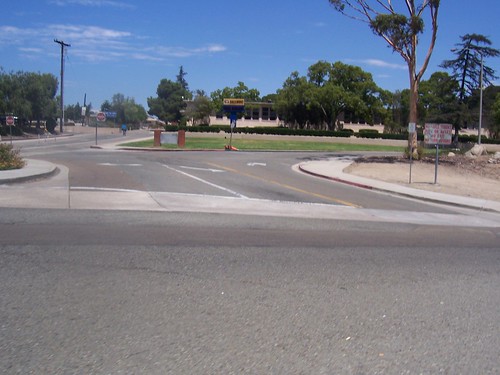
The closest community college is Grossmont College, reachable in a couple of minutes via 125. the closest four year college is San Diego State University.
The back side of the high school on Milden, mostly included because I want to show you the view from the neighborhood to the south. That's Mt. Helix.
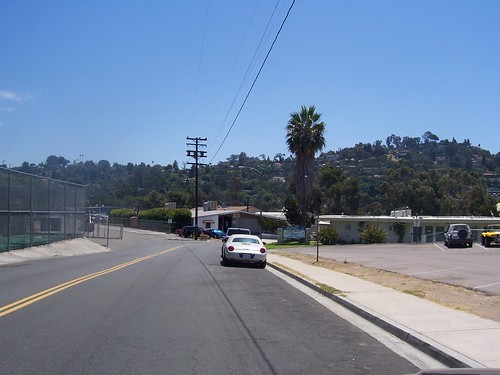
The Griffen Park neighborhood is very well connected to freeway access. There's onramps to and offramps from Interstate 8 at Severin Drive, and you can get to CA 125 pretty easy, too. If you're not on the freeway going the direction you want within a couple minutes of pulling out of your driveway, you're doing it wrong. There's three supermarkets within five minutes and you don't have to get on the freeway. For that matter, Murray Drive drops right into Grossmont Center, and you don't need or want to get on the freeway for that, either. You can get to Mission Valley in fifteen minutes, downtown in 20. The San Diego Trolley runs along Amaya and Water before it crosses Interstate 8 to go down into El Cajon, and there's a station at Amaya.
Major shopping centers are found at Grossmont Center (Target, Wal-Mart, Macy's, Theaters and dining), which is within five minutes, and you can take the trolley or bicycle over. Parkway Plaza (Sears, Wal-Mart, Penneys, theaters) in El Cajon is roughly ten minutes, College Grove (Wal Mart, Sam's Club, Target) about the same.
Point of interest: La Mesa Indoor Soccer arena on Murray Drive

If you'd like to talk more about Griffen Park or any other neighborhood of La Mesa, Contact me. I will be happy to discuss which neighborhoods might be right for you, or the marketing of your current property.
Today's new consumer article is The Moment of Truth, Signing Bad Loan Documents and the Right of Rescission, which discusses the Moment of Truth that happens in every loan - when the loan documents are presented. Ideally, there should be no surprises in those documents, but that's not the way it usually happens, and this article deals with what you should do (don't sign) and what happens if you do.
In real estate, the saying, "An ounce of prevention is worth a pound of cure" is a gross underestimation. It's more like a microgram of prevention is worth several tons of cure. This is a case in point.
Today's new consumer article is Loan Qualification Standards: Qualifying Rate and Payment, which talks about how the calculations that determine whether or not you qualify for the loan you apply for.
Today's new consumer article is Finding or Creating a "Green" or Eco-Friendly House, a short discussion of some of the issues involved in creating a dwelling that's less stressful to the environment.
Newly Written Articles
Why Lenders Don't and Won't Tell Borrowers Their Loan Was Turned Down (Games Lenders Play, Part 9), talking about why lenders will keep quiet about changes in the loan during the process.
What Buyers Need: What Sellers Should Want to Supply, talking about seeing the other side in a purchase.
What Sellers Need: What Buyers Should Want to Supply, talking about seeing the other side in a purchase.
How Do I Know If I've Been Lowballed on a Mortgage Quote?, talking about the steps you can take to prevent it.
Updated Articles
Exclusive versus Non-Exclusive Buyer's Agent Agreement
Non-Recourse Purchase Money Loans in California
Can You Change Lenders After the Loan is Approved?
Rental History and Payment Shock in Applying for a Mortgage
Today's new consumer article is Why Lenders Don't and Won't Tell Borrowers Their Loan Was Turned Down, which discusses why most lenders don't make this very simple disclosure. Basically, it's because they lose money by being honest.
This is a the sixth of the series on the neighborhoods of the area I primarily work, which includes La Mesa, San Carlos, El Cajon and Santee. This time I'm moving to the eastern side of La Mesa.
Northmont is bounded by Fletcher Parkway, Amaya Drive, and the El Cajon City Limits. Fletcher Hills, just north and east but inside El Cajon, is essentially similar, as is the Griffen Park/Murray Drive neighborhood on the other side of Amaya. It's a neighborhood of small hills with a medium number of trees for La Mesa. Most of the streets are fairly wide, and most of the properties have a decent view - with some being spectacular
Gregory street, looking west. That view goes all the way to the coast

The main commercial arteries serving the area are Amaya Drive and Fletcher Parkway, despite there being only limited access to the latter. The businesses tend to congregate in the three neighborhood malls, at Severin and Amaya, 125 and Fletcher Parkway (the former site of Family Fun Center), and Fletcher Parkway and Dallas.
The neighborhood mall at Severin and Amaya, with Mt. Helix in the background:

Physically, there are almost two separate neighborhoods here. Along Amaya and Severin, the homes were built in the 1940s and before, and are typically around 1000 to 1200 square feet, these were originally two or three bedroom, one bath houses that have largely been added onto where they now three bedrooms, and one and a half to two bath. A significant number of these were replaced with higher density housing - apartments and condominiums - in the sixties and seventies. Once you get away from Severin and Amaya, however, the higher density stuff disappears and the neighborhood is essentially 100 percent single family three and four bedroom detached homes built in tracts in the fifties and early sixties, with some additions to those models here and there, but most are fairly close to the original floor plan. The lots start at about 6000 square feet, and I know of individual lots that go over a third of an acre (roughly 14,500 square feet). Asking prices vary as of this writing from around $290,000 for some of the older and smaller ones, up to nearly $600,000 for the high end. People making San Diego Area Median Income may not be able to afford the best houses in the neighborhood without a hefty down payment, but they can buy something very livable.
Looking east across Severin from Manor Drive
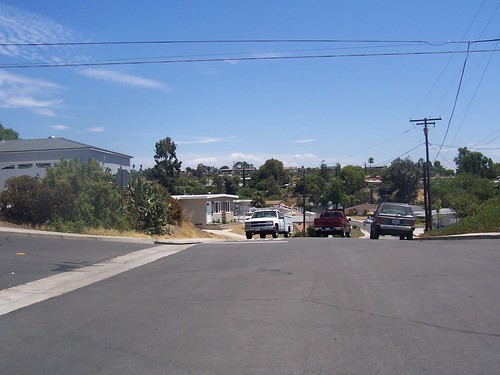
The thing that stands out about the neighborhood is the hills and the views. Around every corner is another view:
Looking south, downhill on Henderson:
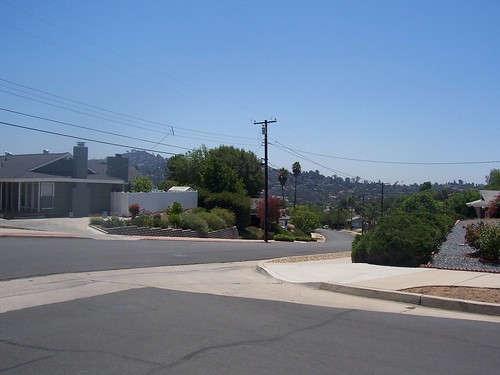
This is not a dense urban neighborhood. The streets are curvy, there aren't always sidewalks, and other than nosy agents, there just aren't a lot of people in the area who don't live here. It's a pretty quiet place to live for the most part, and you would definitely get the wrong impression if you only drove Severin, Amaya, and Fletcher Parkway.
City Limits, where Henderson (La Mesa) becomes Croyden (El Cajon)
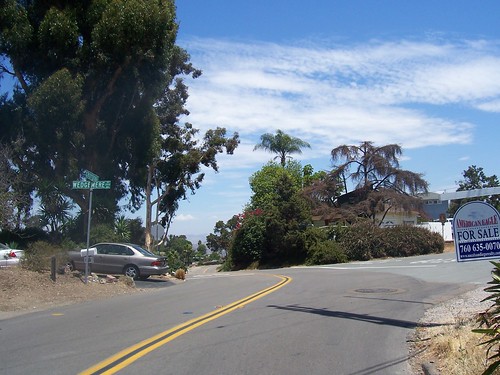
By contrast, here's looking north to where Severin (La Mesa) becomes Garfield (El Cajon)

The neighborhood school is Northmont. The Middle School is Parkway Middle School (formerly Parkway Junior High), and the high school is Grossmont High School, the oldest high school in the Grossmont District. Here's the most recent account Grossmont Accountability Report Card
The front of Northmont Elementary:
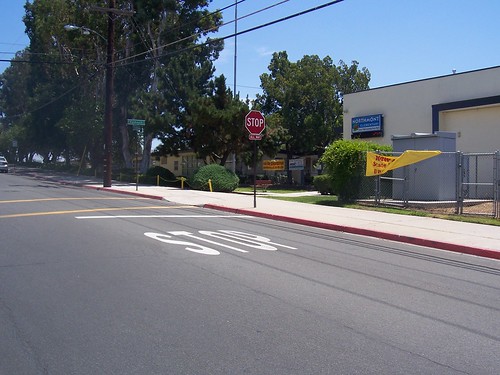
The closest community college is Grossmont College, reachable in a couple of minutes via 125. the closest four year college is San Diego State University.
Norhtmont is a little more isolated that a lot of La Mesa. Nonethless, it does have good freeway and transportation access. It's two minutes up the hill to Interstate 8 via Severin, just across Fletcher Parkway to the newer CA 125 freeway running north south. You have your choice of two major supermarkets within a mile. You can get to Mission Valley in fifteen minutes, downtown in 20. The San Diego Trolley runs along Fletcher Parkway and Amaya in the area, and has a station on Amaya. Fletcher Parkway is also a bus route.
Major shopping centers are found at Grossmont Center (Target, Wal-Mart, Macy's, Theaters and dining), which is within five minutes, and you can take the trolley or bicycle over. Parkway Plaza (Sears, Wal-Mart, Penneys, theaters) in El Cajon is roughly ten minutes, College Grove (Wal Mart, Sam's Club, Target) about the same.
If you'd like to talk more about Northmont or any other neighborhood of La Mesa, Contact me. I will be happy to discuss which neighborhoods might be right for you, or the marketing of your current property.
Today's new consumer article is What Buyers Need: What Sellers Should Want to Supply, a companion article to yesterday's, helping sellers to be successful by thinking like buyers.
Today's new consumer article is What Sellers Need: What Buyers Should Want to Supply, which talks about thinking like a seller for buyers.
This is the fourth installment of a new series I'm starting, on the neighborhoods of the area I primarily work, which includes La Mesa, San Carlos, El Cajon and Santee.
The Maryland Avenue neighborhood is bounded by Lake Murray Park on the north, Lake Murray Boulevard on the west, Parkway Drive on the south, and on the east side, Guessman Avenue and Maryland Avenue itself. The area a little further east off Wellesley Street has a substantially different feel and flavor.
The main commercial artery serving the area is Parkway Drive, a frontage road for Interstate 8. Lake Murray Boulevard has a few businesses mostly right around the intersection of Parkway Drive, and is a major street, but once you get away from Parkway Drive, there's only four or five small stores, and the Starbucks at Kiowa is the only one that isn't basically a mom and pop operation.
A neighborhood mall on Parkway Drive. People come from quite a way off for the Chickenest Restaurant, just left of center (pinkish).

Physically, the houses are mostly smaller, two and three bedroom houses of 1000 to 1200 square feet. Most were built on piers rather than concrete slabs. Many of them have been expanded since they were built, mostly in the 1940s and 1950s, and most of the lots are big by modern standards, 6000 to 7000 square feet. Hardwood floors are more the rule than the exception. Foundation issues and destructive settling weren't exactly unknown in the area, but mostly have been long since dealt with where they existed. Most have garages, split roughly half and half between one and two car varieties. Asking prices start about $320,000 and go up to about $480,000 for detached housing. People making San Diego Area Median Income can easily afford this area.
A typical view of the interior of the neighborhood, looking north on Kiowa Drive from the Intersection with Maryland Avenue:
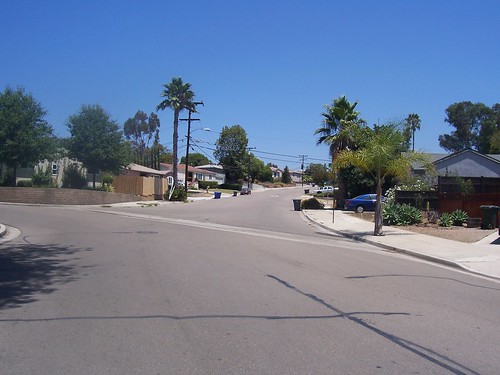
People drive by on the main roads in La Mesa, and assume the neighborhoods are the same, but they're not! If all I ever saw was the main roads, I might not want to live where I do, but knowing the neighborhoods, I love La Mesa!
There is some high density housing in this neighborhood, mostly on Kiowa and Maryland Avenue in the block just south of Lake Murray Boulevard. This area includes one of the only two sets of four bedroom townhomes I'm aware of in La Mesa. These are attractive to older people, those starting out with lots of kids, and others who need a fair amount of space (up to about 1800 square feet) but prefer not to do yard work themselves, like small business owners. Nonetheless, well over half the neighborhood residents are in detached single family dwellings.
Here's a picture of the kitchen of one of the four bedroom townhomes (I took it over a year ago). You can't see the vaulted ceiling they have through most of the living areas, but they are very nice for folks who like the convenience, and have their own garages. Play area for kids, pool, clubhouse - all the reasons some people like townhomes. I may not live there myself, but I certainly wouldn't have any objections to doing so!

Once you get a very small distance away from Parkway Drive and Lake Murray Blvd, the neighborhood is pretty quiet, and nobody aside from residents and real estate agents comes into it. You do get some freeway noise from Interstate 8 right on Parkway Drive and for a few doors to the north of it, but once you get more than a block into the neighborhood, you'd never know the freeway was there from the noise. A lot of this has to do with the fact that the neighborhood goes uphill from there, so the noise gets blocked out.
Point of Interest: Computer Museum of America and Coleman College, in a building that was formerly La Mesa Bowl, on Parkway Drive. If you you're interested in computers, it's a fascinating place!
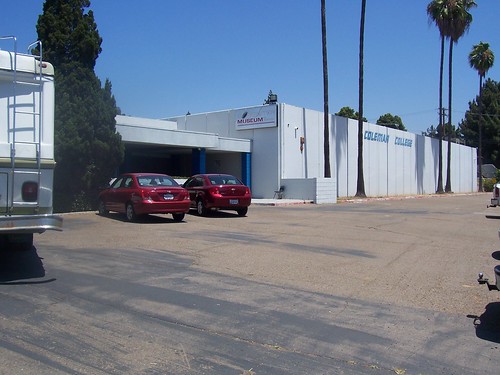
The neighborhood schools are Maryland Avenue, which their website tells me is now a Smart Steps Preschool Site. The Middle School is La Mesa Middle School (formerly La Mesa Junior High), and the high school is Helix Charter. Helix, in particular, has a long record of academic achievement. Here's the most recent account Helix Accountability Report Card. For some reason, lots of people not actually living in the area think that north of Interstate 8 goes to Grossmont High School, but this neighborhood goes to Helix - the real dividing line is approximately Jackson Drive, a mile or so further east.
The closest community college is Grossmont, the closest four year college is San Diego State University, which is actually closer, but both are very easy for residents of Maryland Avenue to got to and back from.
Just north of Lake Murray Boulevard is Lake Murray Park and Lake Murray itself, with all kinds of recreational activities from boating to jogging and hiking around the lake, to a golf course and driving range just across the lake. There are picnic tables and lots of parking if you decide not to walk over. Usually, there's fishing as well, but there's some kind of shellfish infesting the lake at this writing so that's kind of questionable.
Lake Murray Picnic Area (Golf Course is on other side of lake behind the trees on the left) There's a 3.5 mile walking, jogging, and biking asphalt road that goes all around the lake except the dam itself.
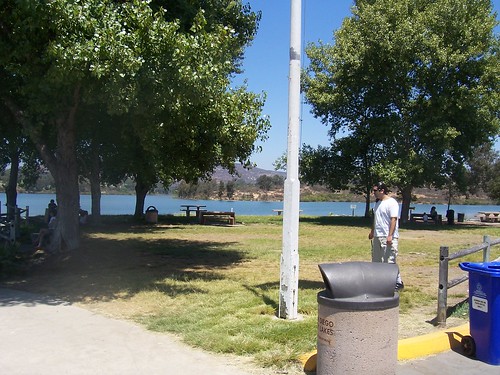
Maryland Avenue neighborhood residents find it easy to go places. It's two minutes or less to Interstate 8, and you don't even have to face any stoplights if you're headed west. There are two major supermarkets within a mile, and if you're a fan of fresh fish, there's a very good fresh fish store at Lake Murray Boulevard and Maryland Avenue. You can get to Mission Valley in less than ten minutes. The San Diego Trolley runs adjacent to Interstate 8, and has stops at Alvarado Hospital and just east of 70th Street. Lake Murray Boulevard is a bus route, and I believe Parkway Drive as well but I can't recall seeing one any time recently. The closest major shopping center is Grossmont Center (Target, Wal-Mart, Macy's, Theaters and dining), and lots of other commercial stuff (Costco, Babies R Us) along Fletcher Parkway, Baltimore and Jackson. College Grove (Wal Mart, Sam's Club, Target) at College and 94 is about three miles, or you can get to any of the major Mission Valley malls in about the same time by car.
If you'd like to talk more about Maryland Avenue or any other neighborhood of La Mesa, Contact me. I will be happy to discuss which neighborhoods might be right for you, or the marketing of your current property.
Today's new consumer article is How Do I Know If I've Been Lowballed on a Mortgage Quote?, which talks about how to nail down lenders on their quotes so that they actually deliver what you expect at loan sign up.
Let's do a thought experiment. Any market in any commodity has two components: The demand, or willingness and ability to pay for that good, and the supply of that good.
Let's consider the demand half of that first. Specifically, ability to pay.
According to the most current credible statistics I could find, San Diego Demographics & Household Information, we have 421,952 workers in San Diego.
Let's consider what this means, first in terms of how much they make, and how many dollars they can afford to lay out:
Column 1 is the range, column 2 is how many workers reported that income, column 3 is percentage of workers in that bracket, column 4 is taking the middle of the range and translating that into dollars per month, and column 5 is what percentage of the total working population can afford that much or better.
Here's the income ranges and frequency:
| Range < $10,000 $10,000-$14,999 $15,000-$24,999 $25,000-$34,999 $35,000-$49,999 $50,000-$74,999 $75,000-$99,999 $100,000-$149,999 $150,000-$199,999 $200,000+ | number 8463 25,745 54,563 54,499 70,654 87,022 50,494 43,452 13,558 13,502 | pct 2.0 6.1 12.9 12.9 16.7 20.6 12.0 10.3 3.2 3.2 | midrange monthly $416 $1041 $1666 $2500 $3541 $5208 $7291 $10,416 $14,583 $20,000* | afford pct 100 98.0 91.9 79.0 66.0 49.3 28.7 16.7 6.4 3.2 |
Now, let's stop a minute here. Someone making less than $10,000 per year is not a full time employee. Minimum wage is $8.00 per hour in California, times 40 hours times 52 weeks is $16,640. So the folks in the first two ranges are not working full time. Period, end of discussion. I think they should have housing, but I have my doubts whether we should be concerned about whether they can afford detached single family residence type housing on their current wages. In most cases, I would posit that they're either teenagers working for pocket money or retirees working for whatever reason strikes them as sufficient. Also, I should mention that I arbitrarily used $240,000 per year as midrange for those folks making over $200,000. Such an estimate is probably too low, but let's face it: Those folks are doing fine.
Now, let's look at what these folks can afford: I took the midrange monthly for that salary range, and assumed they bought, with 5% down, a condominium with HOA dues of $225 per month, or a single family detached home with insurance of $100 per month. This assumes they do all their own maintenance for the detached home, but someone sufficiently determined can at least approach this. I assume property taxes of 1.25% per year (slightly high for most of California), and a fully amortized FHA type loan at 6.5%. For purposes of this exercise, I didn't stress about Jumbo or conforming, as I used the FHA as a basis, nor did I concern myself over whether it fits within FHA limits, as the point of this is simply to perform a thought experiment: How much house people can afford under these assumptions, which are quite reasonable. Once again, it would break down at the higher end of the scale, but folks on that end of the scale are doing fine. I was mostly after was Joe and Jane Average can afford. These numbers given are in terms of the loan amount, not purchase price, which the loan amount was assumed to be 95% of (in other words, $95,000 loan amount means it was $100,000 purchase price).
Column 1 is once again, that monthly midrange, Column 2 is 45% of that, the traditional back end ratio. Column 3 is the maximum condo loan they can afford, under the conditions described, Column 4 is the single family residence, and Column 5 is, once again, what percentage of all workers can afford this level or better.
Let's take a look at the results:
| midrange monthly $416 $1041 $1666 $2500 $3541 $5208 $7291 $10,416 $14,583 $20,000* | Housing+debt serv $187 $468 $750 $1125 $1593 $2343 $3280 $4687 $6562 $9000 | condo limit n/a $32,000 $70,000 $121,000 $184,000 $285,000 $412,000 $601,000 $854,000 $1,183,999 | house limit na $49,000 $87,000 $141,000 $201,000 $302,000 $428,000 $618,000 $871,000 $1,199,000 | afford pct 100 98.0 91.9 79.0 66.0 49.3 28.7 16.7 6.4 3.2 |
So even though someone making $12,500 per year is not a full time worker, they can still afford roughly a $70,000 condo if they want to own badly enough to do what it takes. I'm assuming fully amortized 30 year fixed rate loan, which when the loan is paid off, gets your monthly cost of housing down under the inflation adjusted equivalent of $300 per month in current dollars. There may be only 35 of these currently for sale as I log onto MLS, but I can't tell you why there are any.
Put two of these folks together, a married couple or two friends, it doesn't matter. Remember, neither of them is working full time, and they can afford a $250,000 condo loan under conditions described (Remember, there's only 1 HOA fee, and taxes are only collected once). Insist it be a minimum of two bedrooms, even. There are 3600 Active Listings right now that are asking at or under this price, and almost 3000 have sold in the last twelve months in San Diego County. No, these places aren't right by the beach or in downtown La Jolla, but they are affordable, they're livable, and they put your housing situation and cost forevermore under your own control.
Someone making $15 per hour, in the middle of the fourth range, is about where most folks would start saying, "This is someone who should be able to buy something," and they can: $129,000 worth of condo loan. 594 Actives asking that or less, 383 sold in the last twelve months. Get a roommate, friend, or spouse making the same amount, and you're looking at $273,000 worth of condo, more or less, or $290,000 worth of house. 4100 actives are asking $273,000 or less, even if you restrict your search to two bedrooms or more, and over 3700 of them have sold in the past year. Even if you restrict the search to detached housing, there are 1700 actives where the asking price is $273,000 or less. Two-thirds of all workers can afford this level of housing. In a market where the restrictions on building artificially limit the supply of housing. They may not have travertine floors and granite counters, but the majority of the people in the world would jump at the chance to live in them.
Let's consider someone in the middle of the sixth group, with a spouse in the middle of the fourth. By themselves, that professional can afford $285,000 of condo loan, $302,000 of house loan. Add in the spousal income, and you've got $437,000 worth of condo, $454,000 worth of house. Now, we're just talking over-inflated expectations, unwillingness to economize in other areas of your life, or some combination of the two. In any case, it's no longer affordability - it's that the folks don't want to do what it takes. My Gran had a standard answer for children like that, humiliating and painful, but a lot less so than missing this opportunity will be. Tough old gal, my Gran. Raised a family of six by herself through the Great Depression after second husband died, and she didn't take nonsense or whining from anyone. There are 9500 Active listings where the asking price is under $437,000. I can find you a fairly nice piece of property in pretty much any area of the county for those prices. Just under half of all workers, including part timers, are at this level or better, and the breadwinner (or main breadwinner) is smack dab in the middle of the most common earning range for all workers, and the secondary worker, if we're using one, is two income groups down. People have the ability to pay these prices if they want to. The ones who want to will find themselves sitting very pretty in a few years.
Why do I say that? Because of the supply situation. It's not like we can expand indefinitely in all directions. The Pacific Ocean is wonderful, and it brings a lot of people to visit and most of them want to stay and it helps moderate the climate, but you can't build housing in it. Lots of San Diegans like visiting Mexico, and quite for a number of them, the proximity of Mexico adds a lot to being here in sunny Southern California, but once you cross that border, you're no longer living in San Diego, with all the advantages of life in the United States that start at economic opportunity, run through a government that's actually somewhat accountable to its people, and where there's something resembling a rule of law. Great place to visit, Mexico, but I don't want to live there, where everything is subject to the whims of one of the most corrupt and unaccountable systems of government ever. It appears that pretty much everyone agrees with me. Then there's Camp Pendleton on the north. You can try and take it away from the Marines if you want. I'm not that stupid. They've got the US Government bankrolling them - their armor and weapons and ammo are government issue, which means that you're paying for them to shoot at you. Yes, this is more than a little over the top. The point is, Camp Pendleton is off limits to expansion.
So is most of the eastern portion of the county. Cleveland National Forest, don't you know. Great place to visit, hike, sightsee, camp - but people aren't allowed to live there. 300 million Americans, including all of your neighbors who have already bought and want prices to rise for when they sell, have set up the rules setting that land aside. This might change at some point in the future, but it would take, first, over half of all 300 million Americans changing their mind, then fighting epic court battles as the minority takes every chance possible to keep developers out. They have quite a lot of avenues to stop it; fifty years probably wouldn't be enough. Not to mention eighteen Indian Reservations, and none of the tribes appears eager to sell land to outsiders for tolerably obvious reasons. Lease it, yes. But most people want to own the land, and leasehold property has a fraction the value of land owned outright, even if it's held in a common interest development, because at some point, all leaseholds end and the property, together with all improvements, reverts to the actual owner.
Even in the settled areas where development is possible, look out your window, anywhere in the urban and suburban areas of San Diego. Chances are you're not seeing vacant land. Even if you are, there are zoning and use restrictions and open space preserves. Beyond that, there are permits required and environmental studies to fund, and let's not forget the court battles than pretty much anyone looking to develop open land can expect these days. They started fighting over what's now the 56 corridor in the late 1970s, and the battle still isn't over, by which I mean there's people who want to develop but still have court battles to win and environmental hoops to jump before they can. Question: Do you think all of this makes the supply of available housing greater or less? What do you think constricting the supply of housing does that do to the price of housing? Every time somebody wants to move to San Diego, and there isn't the housing supply for them, two things happen. One, the price goes up by just that little bit necessary so that one person can no longer afford housing. Two, you've either created a homeless person, or someone has been forced to leave.
There are an awful lot of people that want to live here. Add the weather and the beach to the economic opportunity and everything else that the area offers, and you're repeating those two events from the end of the last paragraph many times over. Price going up, people becoming homeless or forced to leave. Multiply them by three million residents of the county, and what do you have? Pricing goes up, up, way up. The "Sunshine Tax" people talk about that we pay for living here is quite substantial. There are areas of the country where two people living on minimum wage can buy a pretty good house. This isn't one of them, and never will be again. The supply is too limited, and the demand too high. Nor is it all housing that we're considering here. It's only that fraction that the current owners have voluntarily decided to sell. If 99% of the current owners are happy where they are and don't want to sell, only 1% of the properties that exist are available for those who want to buy. They bid against each other until enough people drop out of the bidding that there is a one to one match between sellers and buyers.
Let's look at what it took to bring the market to this pass. For several years, more than eight out of ten properties was purchased with an unsustainable loan. People literally did not believe me when I quoted official SDAR and SANDAG statistics that said forty percent of all purchases were with a negative amortization loan, and another forty percent via an interest only 2/28 or 3/27, and both of these were usually stated income. Agents didn't want to tell people to settle for what they could afford, and in the Era of Make Believe Loans they didn't have to. Nor did they want to risk their commission checks by having buyers find out they couldn't afford the prices they were agreeing to pay, and if one loan officer was telling people what they really could and could not afford, there were plenty of others who'd keep their mouth shut and pocket the commission check. Buyers, for their part, weren't exactly models of restraint either. If anyone did try and buck the tide in order to tell them they really couldn't afford a certain property they had their heart set on, they would simply find someone else who'd keep their mouth shut and make it happen.
This all ended rather predictably. Wile E. Coyote looked down, by which I mean that buyers stopped buying. In one of my first on-line articles, I wrote how I had called our county assessor out over this wishful thinking. Prices stopped rising. The increases in value all of the agents, loan officers, and buyers were banking on in order to make the situation not self-destruct came to an abrupt and screeching halt. No increases in value meant that refinances wouldn't fly. Few people could afford new payments, closing costs, pay their loans down enough to enable them to refinance, or do anything else to salvage the situation. Indeed, the sudden wave of all this happening meant there was a veritable tsunami of people who had no other choice but to sell. Indeed, inventory through most of the last three years has been four times or more what it was when the market was hot. When four times as many properties come onto the market, and their owners have no bargaining power, and suddenly nobody wants to buy, it's no surprise the momentum of the market has shifted. It would have been a miracle greater than parting the Red Sea if it hadn't gone the opposite direction just as strongly as it had been going up before. Remember, Supply and Demand.
Let's look at what's happening now. The forgoing chaos created a limited window of opportunity, and that window has started to close. Active Inventory is currently 17,344 listings in San Diego County. This is down almost 1000 in the last month, 5000 in the last four. It's a 24 week supply, down from 26 at the beginning of July. People are figuring this out, despite heavy negativity in the media. The ratios of short sale to foreclosure are shrinking also, as the distressed properties move through the foreclosure cycle. Furthermore, as I said a couple of months ago, a lot of what's out there is still in denial. I was searching detached properties with asking prices below $460,000 in La Mesa earlier in the year and getting roughly 140. I just searched at or below $500,000 and only came up with only 107. Furthermore, it's hit the good stuff disproportionately - all ten of my most recent Hot bargain Properties are off the market. The situation is similar in Santee (104 under $500k now as opposed to mid 130s below $460k), El Cajon (311 vs nearly 400, same circumstances), and San Carlos (18 now vs 33 last time I checked, once again with the maximum search price raised now).
So, does this sound like an overpriced market due for more of a fall, or an underpriced market beginning a recovery? Shrinking inventory at higher prices. Heavy competition for the bargain properties. People able to afford the prices that are being asked with full documentation loans, fully amortized, instead of needing stated income, interest only or negative amortization loans to qualify?
The time of greatest affordability is in the past. If you're looking to buy in San Diego, the time to get off the sidelines is now. The current generation of executives at the lenders who enabled the Era of Make Believe loans has learned their lesson. The ones that survive are not going to relax loan standards to where they were two years ago any time soon. There's not going to be another bubble fueled by speculative loans. There will, however, be an extended period where the disparity between supply of and demand for housing in San Diego is going to get wider and wider, rents are going to increase, if anything, faster than purchase prices, and it's only those who have bought who are in control of their housing situation. Quit trying to time the market - you've already missed bottom, and even the lenders have started admitting it - removing the declining market designation. In case you are unaware, that's a trailing indicator, happening after the fact, not a predictive indicator. If you want to buy here in San Diego at the best prices possible from here on out, it's time to get off the sidelines and act.
If you want to talk, here's my contact information.
For the sellers who have managed to hold off this long, it's only going to get better for the forseeable future, and therefore I'd hold off if I had other options. The only exception is if you want to move up to something more expensive, in which case, let's get a move on! Otherwise, wait. If you're selling to move elsewhere or move down, things are only going to get better as inventory drops and more buyers figure out that we've already hit bottom and are on the way up.
Now, as to whether these conclusions apply outside San Diego County: They do not. There is no such thing as a national housing market, and even a countywide market like I'm talking about here is pretty much a fictional idea, applying only as an amalgamation, as each and every neighborhood of every city in the county is different. But these methods of analysis apply everywhere. In the case of San Diego, they yield an increasingly coherent picture of market recovery. Your local results will vary with your local conditions.
Caveat Emptor
Newly Written Articles
Conforming and Jumbo Only Apply to "A Paper" Conventional Financing
Desperation Mining: How a Buyer Hits Paydirt (and How Sellers Can Avoid it) talking about how to find that property you can get cheap - and avoid being that property that someone got cheap
Consumer Focused Carnival of Real Estate, the monthly carnival for articles written for consumers of real estate.
Updated Articles
Credit Reports: What They Are and How They Work
Probate and Foreclosure and Planning Ahead, talking about how to keep your heirs from losing everything you had because they can't make the payments until the end of probate.
Timeshares, Pro and Con (mostly Con)
What Can You Do If You've Bought A Vampire Property?, a discussion of what to do wrong if you get stuck with a money pit.
Buy My Science Fiction Novels!
Dan Melson Amazon Author Page
Dan Melson Author Page Books2Read
Links to free samples here
The Man From Empire

Man From Empire Books2Read link
A Guardian From Earth

Guardian From Earth Books2Read link
Empire and Earth

Empire and Earth Books2Read link
Working The Trenches

Working the Trenches Books2Read link
Rediscovery 4 novel set

Rediscovery 4 novel set Books2Read link
Preparing The Ground

Preparing the Ground Books2Read link
Building the People

Building the People Books2Read link
Setting The Board

Setting The Board Books2Read link
Moving The Pieces

Moving The Pieces Books2Read link
The Invention of Motherhood

Invention of Motherhood Books2Read link
The Price of Power

Price of Power Books2Read link
The End Of Childhood

The End of Childhood Books2Read link
Measure Of Adulthood

Measure Of Adulthood Books2Read link
The Fountains of Aescalon

The Fountains of Aescalon Books2Read link
The Monad Trap

The Monad Trap Books2Read link
The Gates To Faerie

The Gates To Faerie Books2Read link
Gifts Of The Mother

Gifts Of The Mother Books2Read link
The Book on Mortgages Everyone Should Have!
What Consumers Need To Know About Mortgages

What Consumers Need to Know About Mortgages Books2Read
The Book on Buying Real Estate Everyone Should Have
What Consumers Need To Know About Buying Real Estate

What Consumers Need to Know About Buying Real Estate Books2Read
